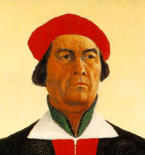
Kazimir Severinovich Malevich (Казимир Северинович Малевич, Polish Malewicz, Ukrainian transliteration Malevych, German Kasimir Malewitsch), (February 23, 1878 – May 15, 1935) was a painter and art theoretician, pioneer of geometric abstract art and one of the most important members of the Russian avant-garde.
Life and work
Malevich was born near Kiev, Ukraine. From 1895 to 1896 he studied at the Drawing School in Kiev. In 1904 he moved to Moscow. He studied at the Moscow School of Painting, Sculpture and Architecture (1904–1910) and in the studio of Fedor Rerberg in Moscow (1904–1910). In 1911 he participated in the second exhibition with the group Soyus Molod'ozhi (Union of Youth) in St. Petersburg, together with Vladimir Tatlin and, in 1912, in the third exhibition with this group, together with Aleksandra Ekster, Vladimir Tatlin and others. In the same year he participated in exhibition of the group Donkey's Tail in Moscow. In 1914 Malevich participated in exhibits of Salon des Independants in Paris together with Alexander Archipenko, Sonia Delaunay, Aleksandra Ekster and Vadym Meller, among others. In 1915 he published his manifesto From Cubism to Suprematism. In 1915–1916 he worked with other suprematist artists in a peasant/artisan co-operative in Skoptsi and Verbovka village. In 1916–1917 he participated in exhibitions of the group Jack of Diamonds in Moscow together with Nathan Altman, David Burliuk and A. Ekster, among others.
After early experiments with various modernist styles including Cubism and Futurism — as exemplified by his costume and set work on the Cubo-Futurist opera Victory Over the Sun — in 1915, in Petrograd, he introduced his abstract, non-objective geometric patterns in a style and artistic movement he called Suprematism; famous examples include Black Square (1915) and White on White (1918).

Malevich was a member of the Collegium on the Arts of Narkompros, the commission for the protection of monuments and the museums commission (all from 1918–1919); later on, he taught at the Vitebsk Practical Art School in Russia (now part of Belarus) (1919–1922), the Leningrad Academy of Arts (1922–1927), the Kiev State Art Institute (1927–1929) and the House of the Arts in Leningrad (1930). He wrote the book The World as Non-Objectivity (Munich 1926; English trans. 1976) on his theories.
In 1927, he went to Germany for a retrospective that brought him international fame, and arranged to leave most of the paintings behind when he returned to the Soviet Union. When the Stalinist regime turned against modernist "bourgeois" art, Malevich was persecuted. Many of his works were confiscated or destroyed, and he died in poverty and oblivion in Leningrad, Soviet Union (today Saint Petersburg, Russia).
Quote
- Painting is the aesthetic side of the object but it has never been original, has never been its own goal. Painters were examining magistrates, police officers who wrote out assorted warrants on spoiled merchandise, on thefts, on murders and on bums. Painters were also attorneys, happy storytellers of anecdote, psychologists, botanists, zoologists, archaeologists, engineers, but there were no creative painters.
Selected works
- 1912 Morning in the Country after Snowstorm
- 1912 The Woodcutter
- 1912-13 Reaper on Red Background
- [1913] 1923-29 Black Circle
- [1913] 1923-29 Black Square
- 1914 The Aviator
- 1914 An Englishman in Moscow
- 1914 Soldier of the First Division
- 1915 Black Square and Red Square
- 1915 Red Square: Painterly Realism of a Peasant Woman in Two Dimensions
- 1915 Suprematist Composition
- 1915 Suprematism (1915)
- 1915 Suprematist Painting: Aeroplane Flying
- 1915 Suprematism: Self-Portrait in Two Dimensions
- 1915-16 Suprematist Painting (Ludwigshafen)
- 1916 Suprematist Painting (1916)
- 1916 Supremus No. 56
- 1916 Suprematism (Supremus No. 58)
- 1916-17 Suprematism (1916-17)
- 1917 Suprematist Painting (1917)
- 1928-32 Complex Presentiment: Half-Figure in a Yellow Shirt
- 1932-34 Running Man
- 1933 Self Portrait
See also
External links and references
- Kazimir Malevich (examples of works)
- Dmitriy Gorbachov, Ukrainian Avant-garde Art 1910-1930s, Mystetstvo, 1996, Kiev, Ukraine.
- Future Exhibition Ukrainian modernism NY, Chikago, 2006, USA
- Kazymyr Malevych, Avantgarde and Ukraine, pp.194-195, Catalog, an Exhibition of the Villa Stuck ,Munich, 1993
- Exhibition L'art en Ukraine, Toulouse, France, 1993.
- Exhibition Ukrainian Avant-garde of 1910s-1930s / Ukrajinska Avangarda 1910-1930. Zagreb, 1991, Croatia.
- Guggenheim: Kazimir Malevich
- "Black Square"
- "White on White"
- "Malevich on Film"
- "Victory Over the Sun" discussed
- The Non-objective World, Kasimir Malevich, trans. Howard Dearstyne, Paul Theobald, 1959
- Kazimir Malevich and Suprematism 1878-1935, Gilles Néret, Taschen, 2003